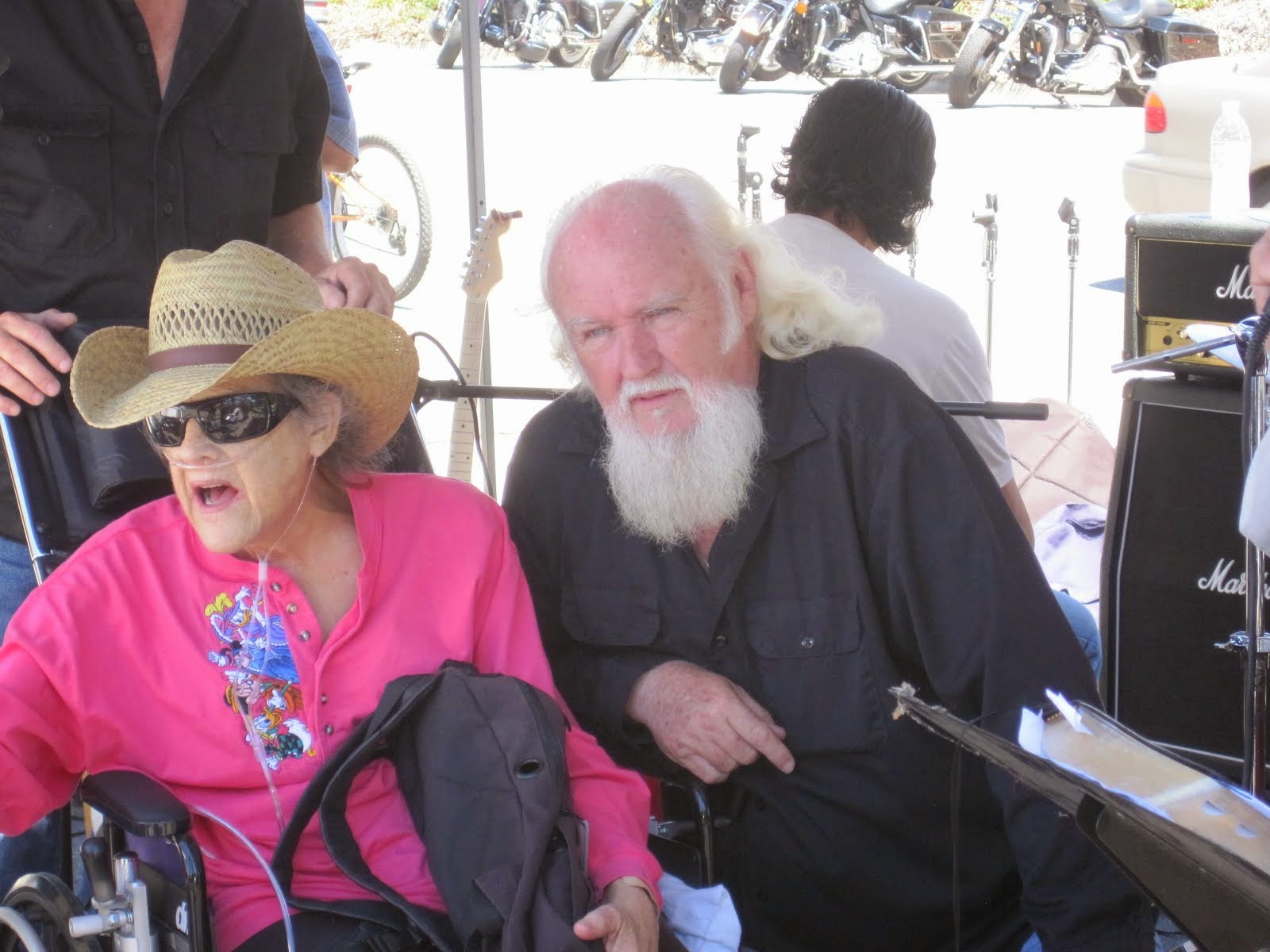OFF THE WIRE
Federal safety officials are hoping states pass more laws requiring helmets.
BY VALLERY BROWN and ROBERT MEDLEY Oklahoman
Motorcycle enthusiasts use the phrase, “It’s not if you go down, it’s when.” When John Pierce was in a hit-and-run accident in August, it was his first serious crash in 50 years of riding.
Pierce, 67, wasn’t wearing a helmet. He chose not to wear one. Oklahoma law requires only riders younger than age 18 to wear them, but federal safety officials are pushing for states to require all motorcycle riders to wear federally approved helmets.
Oklahoma’s helmet laws should be left alone, some motorcyclists say, and so should those in 29 other states that don’t require all riders to wear helmets.
This month, the National Transportation Safety Board put motorcycle safety on its “Most Wanted List of Transportation Safety.” Officials said motorcycle deaths have increased during the past decade, even as other traffic fatalities have declined. There were 4,400 motorcycle deaths in the United States last year. More than 100 of those were in Oklahoma.
Argument over laws
Capt. Chris West, Oklahoma Highway Patrol spokesman, said state troopers see firsthand how deadly motorcycle accidents can be.
“Everyone should wear a helmet,” West said.
But Pierce argues motorcycle riding is inherently risky and numbers don’t tell the whole story. While accidents and fatalities have increased in some cases, so have the number of motorcyclists on the road.
In Oklahoma, the number of registered motorcycles has increased by more than 7 percent since 2008.
“States with mandatory laws have no better or worse fatality records,” said Pierce, referring to a National Center for Statistics and Analysis 2002 report.
Colorado, a state with no helmet laws at the time, had 4.31 fatalities per 100,000 motorcycles registered in the state. Neighbor state Nebraska, which requires helmets, had 5.20 fatalities per 100,000 motorcycles registered in the state, the report shows.
“There is just no way to tell whether a state has a helmet law by looking at the numbers of fatalities,” he said.
Pierce works on behalf of two nationwide associations pushing against motorcycle helmet laws, instead calling for more motorcyclist training and education.
His crash in August happened at night when a driver in a sport utility vehicle didn’t see his motorcycle. Pierce hit the side of the vehicle, smashed his face into the windshield of his motorcycle and was left bloodied on the side of the road. He spent two days in the hospital with a broken nose and injuries to his face and knee.
“It’s a risk we assume,” Pierce said. “But you’re not invulnerable just because you have a helmet on.”
He concedes helmets do increase safety in some situations, but riders should be able to evaluate those scenarios and choose for themselves. Pierce advocates for more biker education and is involved in the planning and implementation of Gunner’s Law, which took effect on Nov. 1. Now, $3 from every motorcycle registration bought in the state will go to a fund to increase education and promote motorcycle awareness.
“The government can try to make crashing safer with helmet laws, or it can do things to try and prevent the crash in the first place,” said Pierce.
In a 1994 study, the state Health Department reported helmets were 60 to 75 percent effective in reducing head injuries.
Non-helmeted riders were more likely to suffer a fatal head injury. Non-helmeted riders were twice as likely to suffer a nonfatal head injury, the report shows.
Some who disagree with helmet laws argue a helmet is more likely to cause spinal cord injury during an accident. However, the report shows little difference in the number of spinal cord injuries on either side of the debate.
skip to main |
skip to sidebar




Bill & Annie

Art Hall & Rusty


NUFF SAID.......


































































OOHRAH

ONCE A MARINE,ALWAYS A MARINE

GIVING BACK


MOUNT SOLEDAD














BIKINI BIKE WASH AT SWEETWATER










FRIENDS





BILL,WILLIE G, PHILIP










GOOD FRIENDS


hanging out

brothers


GOOD FRIENDS

Good Friends

Hanging Out




Bill & Annie
Art Hall & Rusty
Art Hall & Rusty


NUFF SAID.......



















NUFF SAID......



























Mount Soledad




BALBOA NAVAL HOSPITAL
RUSTY DANNY

ANNIE KO PHILIP

PHILIP & ANNIE

OUT & ABOUT

OOHRAH...

OOHRAH
ONCE A MARINE,ALWAYS A MARINE

ONCE A MARINE,ALWAYS A MARINE
American Soldier Network GIVING BACK

GIVING BACK
CATHY & BILL
PHILIP & DANNY & BILL

MOUNT SOLEDAD
bills today
EMILIO & PHILIP
WATER & POWER
WATER & POWER
bootride2013



BIKINI BIKE WASH AT SWEETWATER







ILLUSION OPEN HOUSE

FRIENDS


GOOD FRIENDS



BILL,WILLIE G, PHILIP









GOOD FRIENDS

GOOD FRIENDS
Friends
- http://www.ehlinelaw.com/losangeles-motorcycleaccidentattorneys/
- Scotty westcoast-tbars.com
- Ashby C. Sorensen
- americansoldiernetwork.org
- blogtalkradio.com/hermis-live
- davidlabrava.com
- emiliorivera.com/
- http://kandymankustompaint.com
- http://pipelinept.com/
- http://womenmotorcyclist.com
- http://www.ehlinelaw.com
- https://ammo.com/
- SAN DIEGO CUSTOMS
- www.biggshd.com
- www.bighousecrew.net
- www.bikersinformationguide.com
- www.boltofca.org
- www.boltusa.org
- www.espinozasleather.com
- www.illusionmotorcycles.com
- www.kennedyscollateral.com
- www.kennedyscustomcycles.com
- www.listerinsurance.com
- www.sweetwaterharley.com

Hanging out

hanging out
Good Friends

brothers
GOOD FRIENDS

EMILIO & SCREWDRIVER

GOOD FRIENDS
Danny Trejo & Screwdriver

Good Friends
Navigation
Welcome to Bikers of America, Know Your Rights!
“THE BIKERS OF AMERICA, THE PHIL and BILL SHOW”,
A HARDCORE BIKER RIGHTS SHOW THAT HITS LIKE A BORED AND STROKED BIG TWIN!
ON LIVE TUESDAY'S & THURDAY'S AT 6 PM P.S.T.
9 PM E.S.T.
CATCH LIVE AND ARCHIVED SHOWS
FREE OF CHARGE AT...
BlogTalkRadio.com/BikersOfAmerica.
Two ways to listen on Tuesday & Thursday
1. Call in number - (347) 826-7753 ...
Listen live right from your phone!
2. Stream us live on your computer: http://www.blogtalkradio.com/bikersofamerica.
A HARDCORE BIKER RIGHTS SHOW THAT HITS LIKE A BORED AND STROKED BIG TWIN!
ON LIVE TUESDAY'S & THURDAY'S AT 6 PM P.S.T.
9 PM E.S.T.
CATCH LIVE AND ARCHIVED SHOWS
FREE OF CHARGE AT...
BlogTalkRadio.com/BikersOfAmerica.
Two ways to listen on Tuesday & Thursday
1. Call in number - (347) 826-7753 ...
Listen live right from your phone!
2. Stream us live on your computer: http://www.blogtalkradio.com/bikersofamerica.
Good Times
Hanging Out

Key Words
- about (3)
- contact (1)
- TENNESSEE AND THUNDER ON THE MOUNTAIN (1)
- thinking (1)
- upcoming shows (2)
Blog Archive
-
▼
2010
(4242)
-
▼
December
(595)
- No title
- Canada - TRURO - Startling developments in decade-...
- LOCALS FORGE LAW TO FIGHT MOTORCYCLE THEFT
- DUI - Do you feel your state DUI laws are too stiff?
- Policing the police: No oversight - 2nd Installmen...
- With ‘Sovereign Citizen’ Movement Growing, New SPL...
- UPCOMING EVENTS
- Two indicted on gang-related charges
- FUCK YOU ! Neither 'good' nor 'bad,' fatal police ...
- Fiber Optic Mohawk Helmets. Not For Me. For You?
- CA: Drivers Angered by Freeway Campaign Promoting ...
- JUSTICE DENIED FOR A DISABLED VIETNAM ERA VETERAN ...
- National Police Misconduct NewsFeed Daily Recap 12...
- Canada - Whynott to make court appearance this aft...
- Georgia - Biker babes aid troops, charity
- Scott City, MO - Boot-Heel Harley-Davidson Gives T...
- Australia - Sydney tattoo parlour firebombed
- Australia -Sad loss of a charitable man
- Maine AG: ATF agents justified in shooting biker.....
- California - New state law aims to curb motorcycle...
- Missouri - Patriot Guard bikers proud to block Wes...
- Pro-Gun Argument . . .
- CALIFORNIA - New Motorcycle Law Revs Up Controvers...
- F.Y.I. - FREEDOM OF INFORMATION ACT.......
- Australia - Rival bikie gangs up the ante - Coman...
- National Police Misconduct NewsFeed Daily Recap 12...
- WASHINGTON - DEA transformed into global intellige...
- PROJECT - " NOT GIULTY "
- Happy New Year and Mark Your Calendars for the 201...
- A Premature Alarm Regarding Police Fatality Rates
- FABIAN v. FULMER HELMETS, INC.
- House Checks?
- PROJECT - " NOT GIULTY "
- UNITED STATES - Feds To Require Gun Sale Notificat...
- HARLEY RIM FAILURE!
- Arizona - KINGMAN - 7 alleged Vagos indicted
- The FCC's Threat to Internet Freedom
- 2010 Motorcycle Helmet laws a federal issue again???
- New state laws change rules on drinking, handgun a...
- Scientific Research,Study: Fellatio may significan...
- Back-seat Driver: California toughens motorcycle l...
- ATTIKA7
- New legislation that could potentially affect MC p...
- “THE BIKERS OF AMERICA - THE PHIL AND BILL SHOW”
- California - Santa Clara cop now faces federal cha...
- BOLT of Iraq???
- Last Night's Activism
- Germany - Hells Angels on the rise
- ~ Living Legends ~ Lithograph & Book Signing
- LINKS TO SHARE:
- FABIAN v. FULMER HELMETS, INC.
- U.S. - Monitoring America - "See Something, Say S...
- TENNESSEE: Appeals court orders reconsideration of...
- Pittsburgh officer charged in fatal Sept. crash
- KENTUCKY: This years Ride for Freedom 2011 will be...
- VETERANS BENEFITS ACT OF 2010 SIGNED INTO LAW.
- January 8, 2011 Los Angeles, CA Easyriders Bike Sh...
- More rights stolen!! Now it's the internet!! Thank...
- Washington DC - House to read Constitution - 'We t...
- Fourth Amendment Rights
- Federal helmet recommendation could affect motorcy...
- Motorcycle Helmet laws a federal issue again???
- Off-duty San Diego police officer shoots suspect t...
- New legislation that could potentially affect MC p...
- MEMPHIS, Tenn. (AP) — An appeals court has ruled t...
- Cops' Use of Illegal Steroids a 'Big Problem'
- California Gun Laws: APPEAL FILED IN LAWSUIT CHALL...
- “HERMIS LIVE!”-INTERNET RADIO SHOW-BIKERS: MODERN ...
- OUT OF CONTROL - Cheektowaga, NY - Use of Taser br...
- Winter Motorcycle Tire Tips From Dunlop
- Oklahoma - Police corruption probe to deepen in 2011
- Harley-Davidson, Inc. to report fourth quarter ear...
- UPDATE - Top stories of 2010
- Cyprus - Bikie paymaster faces extradition
- UPDATE - Outlaw bikers convicted in RICO case
- UPDATE - Sex trafficking victims at massage parlor...
- A massage parlor eviction incident in Irvine, CA r...
- HPD Officer Probed in Pill Mill
- Georgetown man says police officer kicked him, bro...
- Pocono, PA - Angels in leather embody spirit of Ch...
- Australia - Rebels bikie citadel up for sale
- California - Former Bell Cop Gets Nine Years in Pr...
- Australia - Christmas party like no other..........
- Australia - Top fugitive nabbed in Cyprus
- National Police Misconduct NewsFeed Daily Recap 12...
- AMA ACTION ALERT - New Omnibus Public Lands Bill i...
- Australia - Bikie sign a hoax: owners
- IMPORTANT NEWS - CNN Breaking News House OKs measu...
- Australia - Gunman 'was taking shots at strip club'
- New rules may result in no fireworks
- INTERNATIONAL NEWS: Jamaica - Police get motorcyc...
- Biker/Santa inspires Club to Hold Toy Drive....
- IOWA: Motorcycle helmets should be required by law
- Australia - Alleged biker bans himself from pubs
- Outlaws Motorcycle Gang Members Found Guilty
- New York - Celebration to recall life of Fran Zygl...
- CHARLESTON, W.Va. - Former prison guard sentenced ...
- CHARLESTON, W.Va - Man who sold cocaine to Pagans ...
- INTERNATIONAL NEWS: Jerusalem - Avi Cohen's injury...
- Illinois - CHICAGO - 'Large Guy' convicted in Chic...
-
▼
December
(595)
Bikers of America, Know Your Rights!... Brought to you by Phil and Bill
Philip, a.k.a Screwdriver, is a proud member of Bikers of Lesser Tolerance, and the Left Coast Rep
of B.A.D (Bikers Against Discrimination) along with Bill is a biker rights activist and also a B.A.D Rep, as well, owner of Kennedy's Custom Cycles
